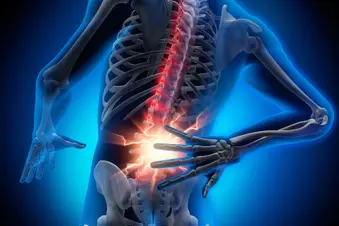
By Jonathan Chan, MD, as told to Hallie Levine
Confused about the difference between ankylosing spondylitis, axial spondyloarthritis, and non-radiographic axial spondyloarthritis? With so many similar-sounding terms, it can be hard to know what’s what. WebMD reached out to rheumatologist Jonathan Chan, MD, for answers to some of your most pressing questions. Here’s what you need to know.
What Is Non-Radiographic Axial Spondyloarthritis?
It’s a type of inflammatory arthritis known as axial spondyloarthritis that affects your spine and the sacroiliac joints. These are the joints that connect your lower spine to your pelvis. It causes pain in your lower back, hips, and butt. There are two classes of axSpA: non-radiographic axial spondyloarthritis (nr-axSpA) and ankylosing spondylitis (AS). If you have the former, it means that doctors can’t see any damage to your joints on an X-ray. But once they start to see them, your condition has become AS.
It’s more common than many of us realize. Up to 6% of people with chronic back pain will ultimately receive a diagnosis of nr-axSpA. The earlier you’re diagnosed, the better your prognosis, and the less likely you are to progress to AS.
What Causes nr-axSpA?
We don’t know for sure, but family history seems to play a big role. You’re more at risk if a first-degree relative, like a parent or sibling, already has the disease. While there are around 30 genes related to its development, one in particular -- human leukocyte antigen, HLA-B27 -- seems to especially increase your risk. Age may also play a role, since symptoms usually start in your 20s. Smoking is a risk factor, too. But unfortunately, I still have plenty of patients who have never smoked, eat right and exercise, and still go on to develop nr-axSpA.
Will My nr-axSpA Turn Into Ankylosing Spondylitis?
That’s hard to say. It’s actually controversial as to whether or not they’re even the same disease. We do know that some people with nr-axSpA will go on to develop ankylosing spondylitis. A 2018 study found that about 5% of patients do so after 5 years, and almost 20% do after 10 years. There do seem to be some risk factors for progression, like having the HLA-B27 gene, or blood tests that show elevated levels of c-reactive protein, a substance that indicates inflammation. But honestly, from a treatment perspective, there’s no difference. All the therapies that we’d use for ankylosing spondylitis work on nr-axSpA, and vice versa. The key is to get an early diagnosis. It can often take more than 10 years.
What Are the Symptoms of nr-axSpA and Why Can It Sometimes Be Missed?
The majority of the time, it’s low back, buttock, and hip pain. But it’s different than traditional back pain. It doesn’t come on suddenly, but happens slowly, over weeks to months to even years. It improves with activity, not with rest, and may be intense enough to wake you up at night. You may also notice morning stiffness that takes a while to go away. About 40% of the time, patients develop other inflammatory diseases, such as uveitis or inflammatory bowel disease.
The problem is that back pain is a common complaint among patients, and the average primary care physician may not realize it could be due to inflammatory arthritis. But I would say if you develop chronic lower back pain before age 45, or already have an inflammatory disease, you should ask your doctor for a referral to a rheumatologist.
How Is nr-axSpA Diagnosed?
There are three things your doctor will need to make a diagnosis:
- An x-ray of the SI joint
- A blood test to check for the HLA-B27 gene
- An MRI of the area
If an X-ray shows no joint damage, but an MRI shows active inflammation, then you most likely have a diagnosis of nr-axSpA. If the X-ray does show damage, then you will be diagnosed with ankylosing spondylitis.
How Is nr-axSpA Treated?
There are three broad categories that include:
Physical therapy and exercise. It’s best to start as soon as possible after diagnosis. It’s very important to do core exercises to take pressure off of your back, along with cardiovascular exercise and strength training. It’s a good idea to see a physical therapist, even if you already work out regularly, to make sure you’re exercising correctly and in a way that won’t cause more joint damage. Since nr-axSpA can cause your spine to “freeze,” posture training is also important.
Nonsteroidal anti-inflammatory drugs (NSAIDs). Prescription medications such as celecoxib (Celebrix) can help control pain and stiffness, but these usually only work in the very early stages. By the time most patients come to see me, they’re not enough.
Biologics. These are a class of drugs that have really revolutionized the treatment of inflammatory arthritis. They work by blocking proteins that cause inflammation. We usually start with a group of medicines known as anti-tumor necrosis factor agents (anti-TNF agents or TNF inhibitors) like infliximab, etanercept or adalimumab. But if patients don’t respond to these drugs, or can’t tolerate them, we try another form of biologics known as anti-interleukin 17 therapy, such as secukinumab (Cosentyx) and ixekizumab (Taltz). Thanks to all of these options, many patients with nr-axSpA are able to manage symptoms and stop the disease from progressing.
Show Sources
Photo Credit: peterschreiber.media / Getty Images
Sources:
Jonathan Chan, MD, assistant clinical professor of rheumatology at the University of British Columbia in Vancouver, British Columbia.
American Journal of Managed Care: “Epidemiology of Axial Spondyloarthritis.”
Current Opinions in Rheumatology: “EPIDEMIOLOGY OF AXIAL SPONDYLOARTHRITIS: AN UPDATE.”
Annals of Rheumatic Diseases: “Diagnosis journey of patients with ankylosing spondylitis in the united states.”